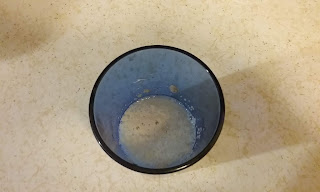Brezeln
In my book The Village Baker: Classic Regional Breads from Europe and America by Joe Ortiz (click here for my review), I have a recipe for pretzels, brezeln in German.
There are several different ways to start bread which boil down to two distinctions, using a starter, or just mixing the yeast directly into the dough. My brezeln recipe uses a starter, a flourless sponge.
Basically, I mixed the yeast into water and let it sit for three hours.
Using a starter versus the direct method (just mixing the yeast into the dough) produces a different flavor and texture to the finished product, and it varies depending on what kind of starter you use. In Mr. Ortiz's book, there are four different kinds of starters: old dough (mixing in a piece of dough saved from bread the day before), sponge, porridge, and sourdough. Sourdough is the hardest to use. I've made bread using the sponge and porridge starters as well as the direct method.
In baking bread, there are several different steps, and most of baking bread is waiting for it to do its own thing while you leave it alone. First, you mix the dough, then you let it rise. Punch it back and let it rise again, then form loaves and bake it. Sometimes there's a third rise, and sometimes loaves are formed between the first and second rise.
The brezeln recipe called for the brezeln to be formed between the two rises. Here they are right after being formed and then brushed with milk and sprinkled with cinnamon and sugar (I prefer cinnamon-sugar pretzels to the traditional salt).
And here they are after the second rise. I know they just kinda look like funny lumps of dough instead of traditional pretzels. I think I'm not making the strands long enough before I twist them into the pretzel shape. It makes the strands too thick so they expand too much into the too small shape. Next time I make them, I'll have to make the strands longer.
The smell of baking bread is fantastic, and these were no exception as they baked in my oven. Here they are fresh out of the oven.
After they cooled, my husband and I dug in. The crust was thick and crunchy, but the inside was soft and chewy. Delicious. It needed more cinnamon and sugar, though.
For any amateur bread bakers out there who wish to refine their skills, I recommend purchasing Mr. Ortiz's book. I could bake bread okay before getting my hands on this book, but his instructions and recipes have expanded my skills and made me into a good baker. I still call myself an amateur because I'm not a professional baker, but I'm certainly no novice.
I'm hoping to try sourdough bread soon with a recipe from Mr. Ortiz's book. I'll let you know how it goes.
There are several different ways to start bread which boil down to two distinctions, using a starter, or just mixing the yeast directly into the dough. My brezeln recipe uses a starter, a flourless sponge.
Using a starter versus the direct method (just mixing the yeast into the dough) produces a different flavor and texture to the finished product, and it varies depending on what kind of starter you use. In Mr. Ortiz's book, there are four different kinds of starters: old dough (mixing in a piece of dough saved from bread the day before), sponge, porridge, and sourdough. Sourdough is the hardest to use. I've made bread using the sponge and porridge starters as well as the direct method.
In baking bread, there are several different steps, and most of baking bread is waiting for it to do its own thing while you leave it alone. First, you mix the dough, then you let it rise. Punch it back and let it rise again, then form loaves and bake it. Sometimes there's a third rise, and sometimes loaves are formed between the first and second rise.
The brezeln recipe called for the brezeln to be formed between the two rises. Here they are right after being formed and then brushed with milk and sprinkled with cinnamon and sugar (I prefer cinnamon-sugar pretzels to the traditional salt).
And here they are after the second rise. I know they just kinda look like funny lumps of dough instead of traditional pretzels. I think I'm not making the strands long enough before I twist them into the pretzel shape. It makes the strands too thick so they expand too much into the too small shape. Next time I make them, I'll have to make the strands longer.
The smell of baking bread is fantastic, and these were no exception as they baked in my oven. Here they are fresh out of the oven.
After they cooled, my husband and I dug in. The crust was thick and crunchy, but the inside was soft and chewy. Delicious. It needed more cinnamon and sugar, though.
For any amateur bread bakers out there who wish to refine their skills, I recommend purchasing Mr. Ortiz's book. I could bake bread okay before getting my hands on this book, but his instructions and recipes have expanded my skills and made me into a good baker. I still call myself an amateur because I'm not a professional baker, but I'm certainly no novice.
I'm hoping to try sourdough bread soon with a recipe from Mr. Ortiz's book. I'll let you know how it goes.
Photo Credit: Katherine Elizabeth







Comments
Post a Comment